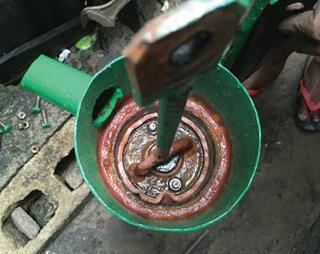
25 minute read
University
ENGINEERING FOR PUBLIC HEALTH Partnership brings safer drinking water to Madagascar
USF COLLEGE OF ENGINEERING Professor James Mihelcic was visiting Tamatave on the east coast of Madagascar to see the work some of his former graduate students were doing on water sanitation and hygiene. That’s where he stumbled upon local artisans building hand pumps used to access shallow groundwater.
“Right in front of us, one of these artisans melted down old lead car batteries over a charcoal fire,” he says. “He poured some molten lead into a small depression in the ground he’d made from a soda pop top. Then, bingo. He had a piece for the two check valves you find in a suction pump.”
Troubled Waters
Just watching the demonstration was enough to tell Mihelcic and his colleagues that lead in the drinking water probably exceeded the World Health Organization’s (WHO) recommended amounts, but they tested samples anyway. Some of them came back at 100 micrograms per liter, 10 times what the WHO says is acceptable.
Lead in drinking water is neither a new problem nor one unique to developing countries like Madagascar. Consider the public health crises surrounding drinking water in places such as Flint, Mich., Newark, N.J., and Jackson, Miss. Lead is a toxic chemical pervasive in the environment. How long and how significant one’s exposure determine the severity of the health problems it causes, but overall lead exposure can damage the brain, kidneys and nervous system and slow physical and intellectual development in children.
Pumping Iron
With the help of funding from a variety of sources, including Water Charities, Pure Earth, a USF Strategic Investment Pool award and his own personal savings, Mihelcic and his team developed a training program for local manufacturers of hand pumps that would teach them how to replace lead components with locally manufactured iron ones.
The team consists of Assistant Professor Mahmooda Khaliq Pasha, PhD ’16, from USF’s College of Public Health, Professor Jeffrey Cunningham and Assistant Professor Katherine Alfredo from the College of Engineering, and some dedicated graduate students. They’re partnering with Ranontsika, a Malagasy non-governmental organization whose aim is to improve public health by promoting access to high-quality drinking water. Local health clinics are also involved in testing the blood levels of children in the community and educating their parents about the health problems associated with lead exposure.
“After our intervention of retrofitting hand pumps with iron valve components, lead water concentrations were
Above: An inside look at the pump.
Right: The project did a preliminary pump adaption at this woman’s house. Here, she is using the pump after adaption.


Above: Malagasy healthcare worker performs a blood lead level test on a baby in a community health clinic.
Right: Two Malagasy health-care professionals run through the protocol for blood lead level testing using a machine that analyzes lead levels using a single finger stick.
reduced below the WHO drinking water guideline of 10 micrograms per liter in 98 percent of pumps,” says Mihelcic, who also directs USF’s Engineering for International Development program. “The percent of pump systems that had lead concentrations reduced below our analytical detection level increased from 9.6 percent to 64 percent. It’s quite a striking improvement for a very simple fix.”
Changing out the lead components to iron ones costs about $4 per pump, Mihelcic says — a worthy expense when you factor in what lead poisoning can cost a community.
“When you consider how a country’s economy suffers because of the loss of IQ of its children, the return on the investment is extremely high,” Mihelcic says. “Prior to the intervention, we estimated that 35 percent of exposed children had a blood lead level greater than the CDC action level [5 micrograms per deciliter or less] and after the intervention we estimated only 14 percent of exposed children possessed elevated blood lead levels.”
Selling Safety
Turns out engineering a non-leaded valve replacement was the easy part. Getting the local technicians to use it — and the community to demand it — proved harder.
That’s where Pasha’s expertise came in.
Pasha is an expert in social marketing, which is behavior change — founded on commercial marketing principles — that brings about social good. She’d been collaborating with Mihelcic and some current and former students on the project on an informal basis but got more involved when she applied for an internal College of Public Health grant inviting collaboration across strategic areas.
“As you can imagine, in a community with not a high level of understanding of lead and its health consequences, sudden change in the norm can create a sense of unease,” Pasha explains. “That’s especially true if it’s initiated by folks who aren’t necessarily representatives of your community.”
Pasha and her team decided to target their social marketing campaign to the technicians locals used to fix and maintain their water pumps.
They spoke to the technicians and translated their findings into a strategy and branded initiative, holding informational and technical sessions and providing inthe-field assistance. After their training, the technicians received certificates signed by the Ministry of Health and Water along with T-shirts and overalls with the project’s branding -- all important signals to the community that the project was professional and the technicians trustworthy, Pasha says.
With technicians on board, Pasha and her team are now turning their attention to the community.
“We found that sometimes the technicians didn’t want to use lead, however, a customer would insist on it because of the look of the metal or the perception that it’s heavier and better for the pump,” Pasha says. “We have intervened midstream through our work with the technicians, and now we’ll focus our work downstream so that there’s a common understanding among the community. Our project is a model for translational science. Any work that the engineers do in the future is complemented by the expertise of behavioral scientists who work to better position the product, service or behavior.”
More information about this international, interdisciplinary project is available at global-lead-pollution.eng.usf.edu.
- DONNA CAMPISANO | College of Public Health
P hotos: Courtesy of JAMES MIHELCIC
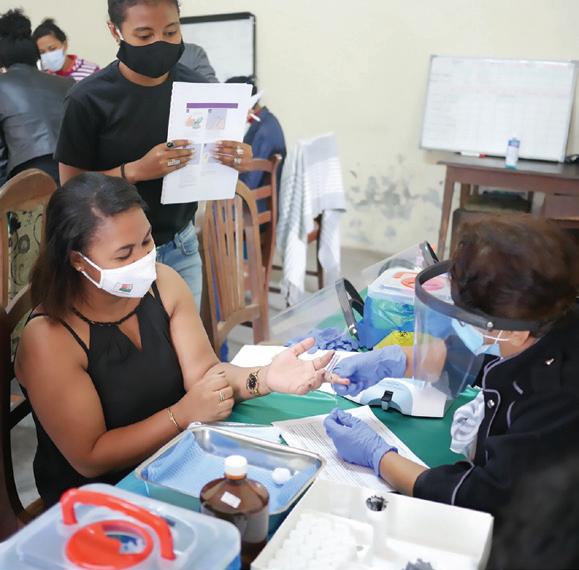
University
A REAL ACHIEVEMENT SpaceX hosts SmallSats – miniature satellites built by USF students and faculty
THREE OF THE 143 SATELLITES ABOARD spaceflight company SpaceX’s first dedicated rideshare mission that launched in January were engineered by students and faculty at the USF Institute of Applied Engineering (IAE).
The mission hosted satellites from dozens of nations and set a world record for the most satellites launched into space on a single mission.
Called SmallSats, the miniature class of cubic satellites that USF students and faculty built are around the size of a softball. SmallSats have a history of use in low Earth orbit, and the team at USF IAE aims to use theirs to research inter-satellite networked communications. Dubbed SXRS-3 by Spaceflight, the January launch was the company’s first mission of the year and the debut flight of the Sherpa-FX vehicle.
USF electrical engineering doctoral candidate and IAE Senior Research Engineer Peter Jorgensen said the satellites will communicate both with each other and with IAE headquarters.
“Effectively, the network is supposed to behave like the Internet here on the ground,” Jorgensen says. “Something like that doesn’t really exist in space right now.”
Ongoing since August 2017, the project to create this network of SmallSats is titled Articulated Reconnaissance and Communications Expedition (ARCE-1). Before finding a home at IAE, it began at the U.S. Special Operations Command innovation incubator known as SOFWERX, with Jorgensen as program manager; Tim Baxter, IAE executive director of programs and customer engagements, as co-PI; and Robert Bishop, dean of the College of Engineering and president and CEO of IAE, as principal investigator.
Bishop said the launch marked a vital milestone for the project and the creation of research opportunities for potentially years to come.
“Having witnessed this project’s progress over the last 3 1/2 years through collaborations with multiple university partners, seeing all three ARCE-1 SmallSats enter orbit was a testament to this mission’s beginnings and its future potential,” he says. “This current success is the result of the intellectual and creative talents of the IAE’s students and staff in tackling tomorrow’s technological endeavors.”
A notable local partner to the project is the Florida High Tech Corridor Match Grants Research Program, which has multiplied the impact of ARCE-1 sponsor awards across different phases of the project and is focused on research and student engagement.
While full-time staff engineers worked on the project last year, Jorgensen said that the satellites were built and tested primarily by USF students of various STEM backgrounds who joined the team.
“Students have been at the center of this project,” he says.
More than 20 USF students across most engineering majors have worked on the project in some way, with a maximum student team size of almost a dozen at one point. Currently, the team consists of four USF students who spent the weeks leading up to the January launch completing and testing each of the three satellites.
Catherine Wood, a fall 2020 USF physics alum, joined the project in September 2020 and said she joined near
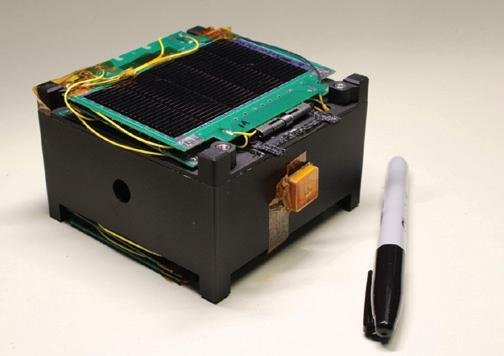
P hoto: PETER JORGENSEN | Courtesy USF Institute of Applied Engineering
Above: SpaceX flight Transporter-1 launched from Space Launch Complex 40 at Cape Canaveral Space Force Station in Florida.
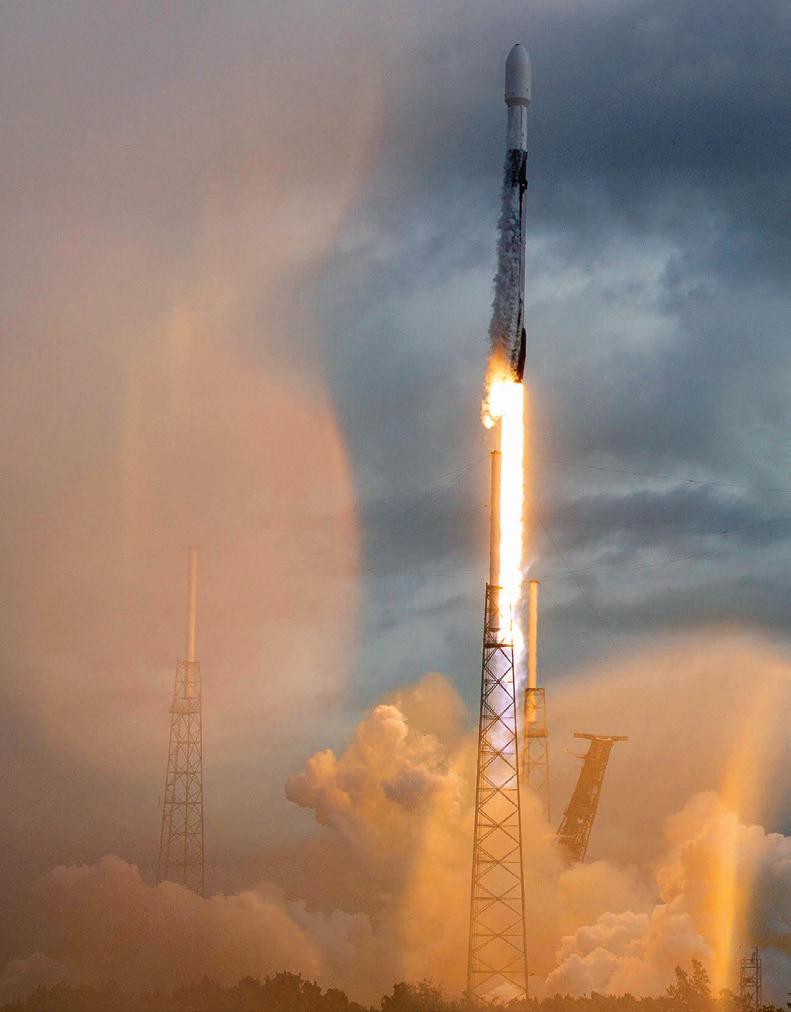
Left: An ARCE-1 satellite.
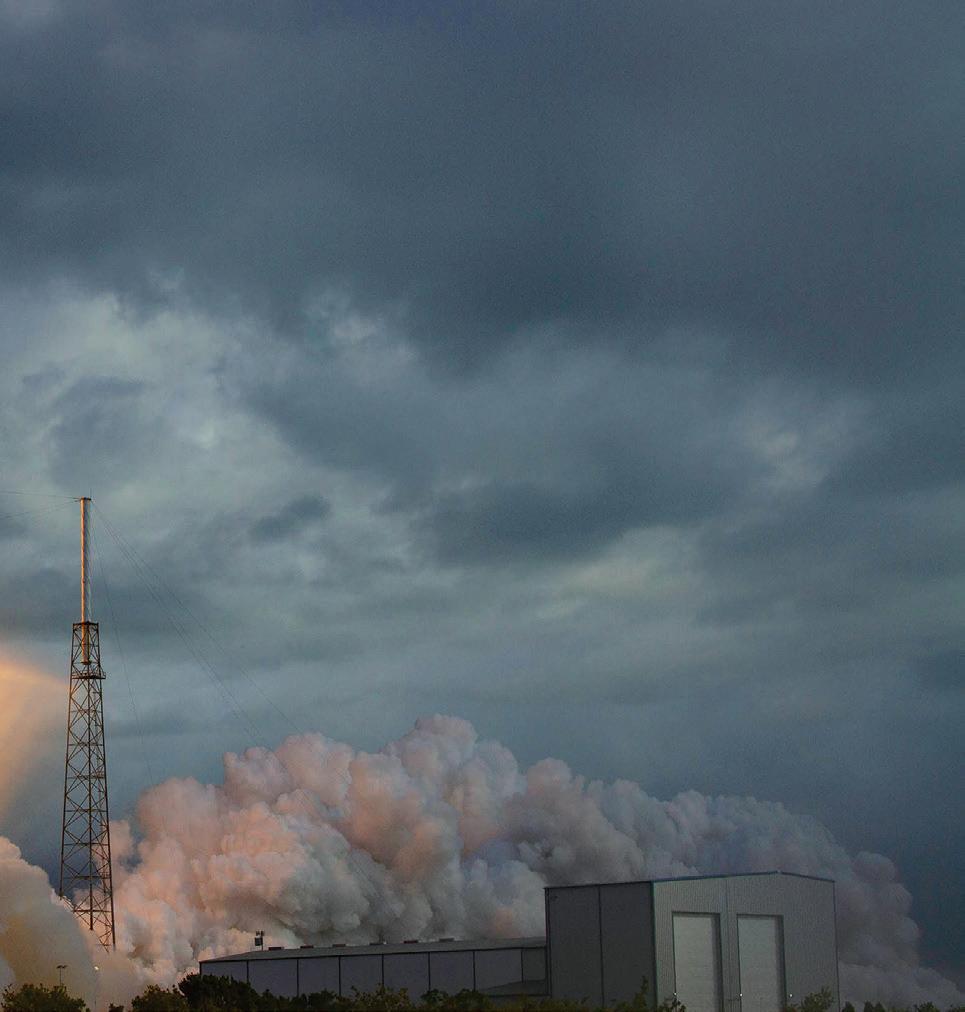
Above: USF electrical engineering doctoral candidate and IAE Senior Research Engineer Peter Jorgensen says the satellites will communicate with each other and with IAE headquarters.
Photo courtesy of SPACEX
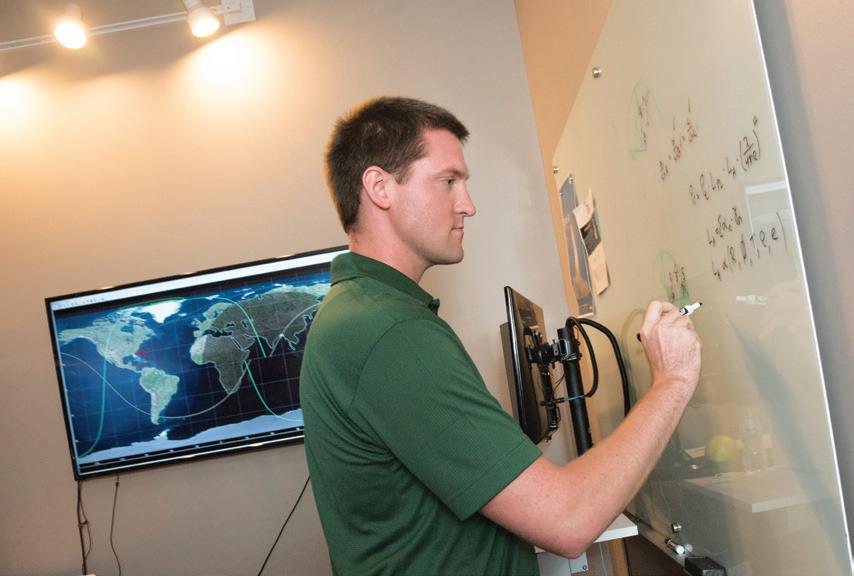
the end of the satellites’ physical development during the project’s testing and deployment integration phases.
Wood said she’s always wanted to work in the aerospace industry and that getting hands-on engineering skills and experience from this project as part of her current internship with the U.S. Department of Defense has given her a valuable look at a future in the field.
“This was a perfect and absolutely outstanding experience to have as an undergraduate student and now recent graduate,” she says. “A constellation of small cube satellites built primarily by young college students, then being launched by one of the biggest aerospace companies? It’s a real achievement. It made me feel really proud about what I’ve been learning and doing at USF, and I’ll carry this experience and what I’ve learned in every aspect of my life.”
David D’Angelo is a recent graduate from a USF mechanical engineering master’s program and joined the IAE team in May 2019. D’Angelo said that building and testing SmallSats has been an interdisciplinary experience and an opportunity to professionally branch out beyond his field. The rigorous process of ensuring each satellite functioned nearly identically and could withstand a suite of tests and simulations — from the force and heat of a rocket launch to power consumption while in orbit — has also made him a more confident engineer.
“Watching our work enter orbit was a great moment to reflect on the culmination of all of our past and present team members’ efforts,” D’Angelo says. “We accomplished something that takes a lot of time and dedication, and seeing that realized was special.”
With all three SmallSats in orbit, Jorgensen says the team’s next task is to complete an orbital analysis of the satellites’ path around the Earth and use the next several weeks to prepare for the project’s next research phase. Then, they can push software updates to the satellites to expand their functionality.
While this initially includes the ability for each SmallSat to autonomously sense how far it is from a message target — maximizing messaging efficiency — the network could one day provide mobile communication services to locations almost anywhere on the globe.
“The intent would be to expand communications capabilities to less connected areas of the Earth,” Jorgensen says. “For example, if a major disaster happened that wiped out all cell networks and all Internet in a large area, these satellites could theoretically be used for communications from that area.”
- RUSSELL NAY ’18 | College of Engineering
University
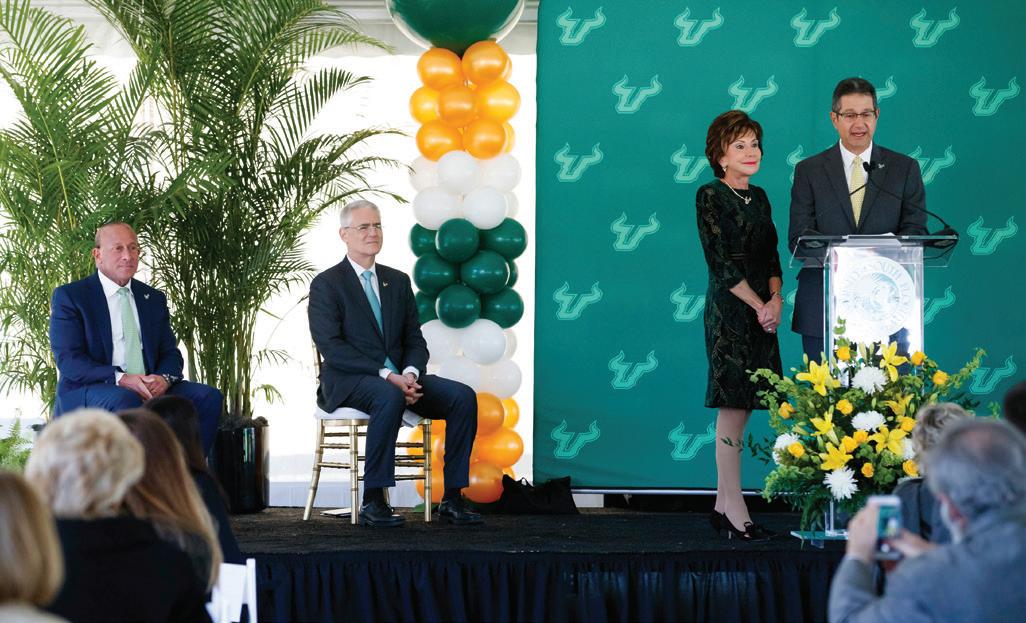
Construction begins on new home for Judy Genshaft Honors College
CONSTRUCTION IS UNDERWAY on the new home of the Judy Genshaft Honors College.
A small groundbreaking ceremony was held on Dec. 1, 2020, for the five-story, 85,000-square-foot facility on the Tampa campus.
“The Judy Genshaft Honors College building will be a remarkable enhancement to our world-class Honors College and will benefit our university, students and faculty,” USF President Steven Currall said at the ceremony. “The new building will advance USF’s strategic goals and long-term aspirations to attract and support Florida’s most accomplished students. We are deeply grateful for the generosity of Judy Genshaft and Steve Greenbaum.”
Private gifts totaling $43 million have been pledged and received for the project, including a historic collegenaming gift of $20 million from USF President Emerita and Professor Judy Genshaft and her husband Steve Greenbaum.
“President Emerita Genshaft’s and Steve Greenbaum’s philanthropy continues to transform USF,” USF Board of Trustees Chair Jordan Zimmerman said. “On behalf of the Board of Trustees, we thank them for their steadfast commitment to student success and their vision that help propel the university to new heights.”
Additional generous gifts have been made by friends of the college, including an anonymous foundation which has provided a challenge gift that will match any future gifts to the building dollar for dollar.
The new facility will feature interwoven spaces for classrooms, study areas, faculty and advisor offices, event areas, a computer lab, performance and creative spaces, and numerous areas for student collaboration — expanding the range of academic opportunities for students and giving them a true “home” on campus. Fittingly, it is being built along the renamed USF Genshaft Drive (formerly USF Maple Drive).
“Having one of the premier honors colleges in the nation is just one way USF will distinguish itself as one of the most elite and forward-thinking institutions in the world,” Genshaft said. “This stellar new home for our already excellent college will help attract top talent to USF, making an indelible impact on our community for years to come. We are delighted to see this dream become a reality.”
By moving from the current location on the second floor of the John and Grace Allen building, the college expects to grow from its current 2,400 students to a total of 3,000 students.
“Shortly after becoming USF’s president, Dr. Genshaft decided to elevate the university honors program to the status of a college,” said Charles Adams, Judy Genshaft Endowed Honors Dean. “She and Provost Ralph Wilcox provided the college with the university resources needed to support its expanding population, and she and Steve provided very generous scholarship support. All this work, and the work that she has inspired in others, has been directed to one goal — to build one of the premier public honors colleges in the country.”
The state-of-the-art building is expected to be completed in late 2022. “We look forward to welcoming our students to our new home and seeing all the amazing work they will do there,” Adams said.
President Emerita Judy Genshaft and husband Steve Greenbaum celebrated the groundbreaking of the Judy Genshaft Honors College building with, from left, Jordan Zimmerman, Chair of the USF Board of Trustees, and USF President Steven Currall.

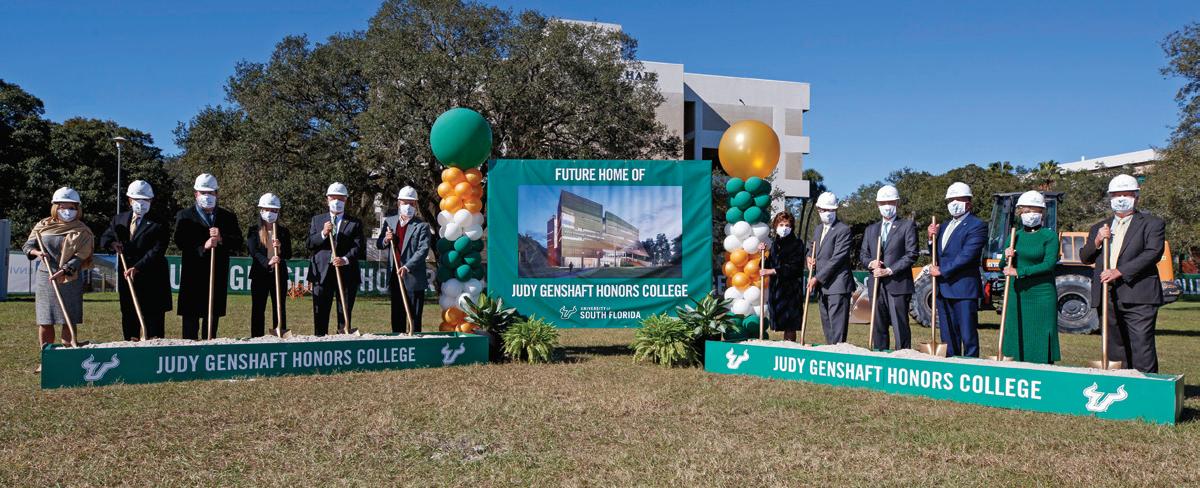
University

USF virologist Michael Teng calls vaccines a ‘tremendous achievement.’
Q&A WITH AN EXPERT Virologist lauds vaccine technology
THE RACE FOR A COVID-19 VACCINE BEGAN when Chinese scientists published the genetic sequence for the SARS-COV-2 virus on Jan. 11, 2020 – a full two months before the World Health Organization declared the novel coronavirus outbreak a global pandemic. Less than a year later, the U.S. Food and Drug Administration approved two vaccines for emergency use within a week of each other (Dec. 11, 2020 and Dec. 18, 2020). Shortly thereafter, the initial COVID-19 vaccine distributions began in the United States. Both these frontrunner vaccines – the first made by Pfizer and its partner BioNtech, and the second by Moderna – are based on new messenger RNA (mRNA) technology.
“As someone who has worked on vaccines for decades and studied RSV (respiratory syncytial virus), which still has no vaccine 60 years after its discovery, I’m excited about the tremendous achievement of this new mRNA technology,” said USF Health virologist Michael Teng. “It’s been an incredible story to watch unfold – just 11 months from identifying a new pandemic virus to actually getting a safe and effective frontline vaccine.”
We caught up with Teng recently to find out more about the science behind the mRNA vaccines, each requiring two doses several weeks apart. He comments on some other vaccine issues as well. The following Q&A has been condensed and edited for clarity.
How do these mRNA vaccines work?
The Pfizer/BioNTech and Moderna mRNA vaccines are based on the same principle as other COVID-19 vaccines in advanced stages of development. These vaccines deliver genetic material that provides the instruction code for your body’s cells to produce a viral protein (antigen). Your immune system recognizes that viral protein as foreign to your body and mounts an immune response to protect against it. For SARS CoV-2, the antigen is the viral spike (S) protein, which is located on the outside of the virus and allows the virus to enter a human cell in order to replicate.
The Pfizer/BioNTech and Moderna vaccines use messenger RNA (mRNA) as the genetic material and encase it in a protective lipid nanoparticle (small bubble of fat) for delivery. Once inside your cells, the mRNA can be translated directly by your cells to make the crown-shaped SARS CoV-2 S. The first (priming) dose of the mRNA vaccine trains your immune system to recognize the viral protein and the second dose boosts your immunity. So, after vaccination, if you are exposed to the actual virus your immune system is ready to neutralize the virus quickly.
In contrast, adenoviral vector vaccines, such as those developed by Oxford/AstraZeneca and Johnson & Johnson (Janssen), employ a DNA gene that encodes the SARS CoV-2 S protein as the genetic material and uses common cold virus particles (rendered harmless) as the delivery system. For these vaccines, the DNA first has to get into the cell nucleus where your cells can make the mRNA coding instructions, which must then be translated into production of the spike protein.
If the mRNA vaccine uses brand new technology, how could it be turned around so quickly?
While mRNA technology is relatively new and was never approved before COVID-19, the research on vaccines using a genetic approach is not.
Both companies (BioNTech and Moderna) have been testing the application of this platform against other infectious diseases and cancers for several years (i.e., Moderna has worked on mRNA vaccines for Zika and the flu). But, until now, none of the mRNA vaccines or therapeutics have made it through advanced clinical trials.
The challenge has been delivering the mRNA, which is very unstable, to its target human cells without the vaccine being degraded too quickly by the body’s naturally occuring enzymes. You want to make sure the mRNA stays around long enough to make sufficient protein to stimulate an immune response, but not so long that it overstimulates the immune response. … Both Pfizer and Moderna found a way to chemically hide the mRNA from the immune system so once it gets into your cells it has enough time to make the viral protein needed to trigger antibodies and activate T-cell production. The mRNA never enters the cell nucleus or alters a person’s genetic makeup.
What are the advantages of mRNA vaccines?
Well, we know they are relatively safe — and 90-plus percent efficacy for a vaccine (94-95%) is really very high. That level of protection rivals what we see with the measles and human papillomavirus (HPV) vaccines. Seasonal flu vaccines are only about 50 to 60 percent effective in a good year.
Another big advantage of this mRNA platform is that it’s easy to change (mRNA coding instructions) based on the disease you are targeting. You just need to swap in the gene sequence of the protein you want encoded to produce an immune response. So, theoretically, you can easily adapt the vaccine to respond to new viruses – or even mutations of the existing virus.
What are the drawbacks?
The major drawback of the mRNA vaccines is that we have not had yet fully marketed this particular type of vaccine. So, we still do not know the long-term effects of the vaccine, or how long immunity lasts.
The mRNA vaccines are significantly more expensive than the adenovirus vaccine and others in the pipeline for COVID-19. And the cold-storage requirements (-94º F for the Pfizer vaccine and -4º F for the Moderna vaccine) may limit distribution.
SARS-CoV-2 variants recently emerged that may make the virus more contagious. Will current COVID-19 vaccines protect against the mutated virus, or will we need new ones?
It will take some time to get answers. But, it’s important to know that RNA viruses like coronaviruses mutate, or change, quite frequently. Not every mutation makes the COVID-19 virus more dangerous or contagious; most have no effect, and others may even weaken the virus. Also, there are several sites (epitopes) on the SARS CoV-2 S protein that are recognized by antibodies. It is likely that multiple sites would have to mutate for the virus to escape the immune response from the vaccines. The current vaccines should cover the newly emerging 20B/501Y.V1 variant originally identified in the UK that has recently been found in Florida.
The bigger question is if we can vaccinate everyone within the next year, or year and a half. How much pressure will that put on SARS-CoV-2 to develop variants that escape immunity? It could happen; I don’t think this virus is going to magically disappear.
The most recent study I saw indicated that natural immunity to other coronaviruses seems to last about three years. The COVID-19 virus may become endemic like these other human coronaviruses that cause the common cold. That means you might need to return for a booster providing better immunity against new viral protein mutations — kind of like we do with the seasonal flu vaccine, which changes a little each year.
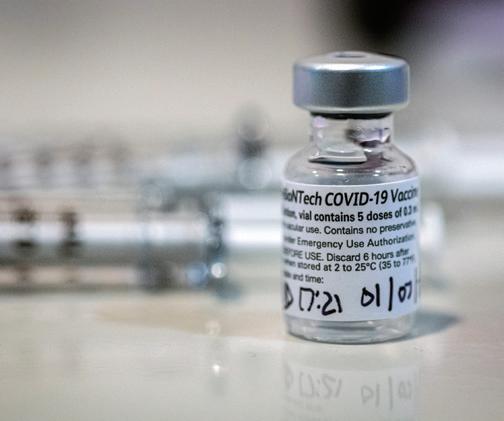
P hoto : C ourtesy USF Health
Would you get one of these first COVID-19 vaccines?
Absolutely, I’ll get vaccinated as soon as I can.
Most short-term side effects are in line with other established vaccines we’re familiar with – including injection site soreness, muscle stiffness, fever, headache, maybe some chills. These symptoms may occur more commonly with the second dose when your immune system is ramping up. It’s not the vaccine itself causing the side effects, but rather the routine response of your immune system to a vaccine that’s working.
The risk-benefit calculation is simple for me. I’d rather take my chances of getting a headache than being on a ventilator with COVID-19.
Athletics
ALUMNI The sky’s the limit for former Bulls linebacker Sam Barrington
WHETHER IT’S WEARING A HELMET OR A HARDHAT, former standout Bulls linebacker Sam Barrington was destined for great things as a proud pillar of a USF community he was drawn to for special reasons.
“I had (scholarship) offers from everybody, but I came to USF because I knew that the school was going in a wonderful direction,” Barrington says. “Here it is 12 years later, and the university is building and I’m involved in it.”
After serving as a staple of his alma mater’s defense from 2009 to 2012, Barrington recently played another important role for the Bulls by successfully contributing to a key construction project in the USF Research Park.
Sky Limit Equipment LLC, a minority-owned business managed by Barrington, used one of its cranes, capable of lifting 250 tons, to hoist the final beam on USF’s new structure. Prior to the “topping off” ceremony, Sky Limit was setting more than 60 pieces of steel per day since beginning work before the Thanksgiving holiday, ensuring a strong structural foundation for the 120,000-square-foot building located at the corner of Fowler Avenue and Spectrum Drive.
“We understood the significance of time in terms of performance and what we had to get done, so we could stay on schedule,” Barrington says. “Fortunately, we were able to exceed those expectations.”
Barrington, COO of Orlando-based Sky Limit Equipment LLC, oversaw the massive task from start to finish while visiting the jobsite at least twice each week. He does the same for many other company projects, constantly checking in with operating engineers and making sure the customer remains happy, especially one near and dear to his heart like USF.
“It’s just amazing,” Barrington says of the Bulls’ most recent building development. “A lot of hard work goes into it and you want to make sure you do a good job because it’s your alma mater.”
Tireless efforts started right away, with 14 trucks hauling the Manitowoc 888 crane to USF before six Sky Limit representatives assembled it in one day. It required another six people to complete the crane disassembly after an immense amount of steel filled the three-story structure.
USF Research Park’s new building, located at the gateway to the Tampa campus, will feature a state-of-the-art, mixed-use lab and offices, with space for retail and dining options on the first floor. Thanks in part to Sky Limit Equipment LLC’s steady progress, the $42 million building remains on track to be finished by late 2021.
“I’ll be able to walk the halls of that building, not only as an alum who is proud that we have these types of facilities but knowing that my company was able to build here,” Barrington says. “It shows USF’s commitment to alumni as well.”
Although he received numerous All-Big East individual accolades with USF football, Barrington always remained a team-first Bull who praised his peers. Naturally, he credits numerous others for making the USF Research Park project possible.
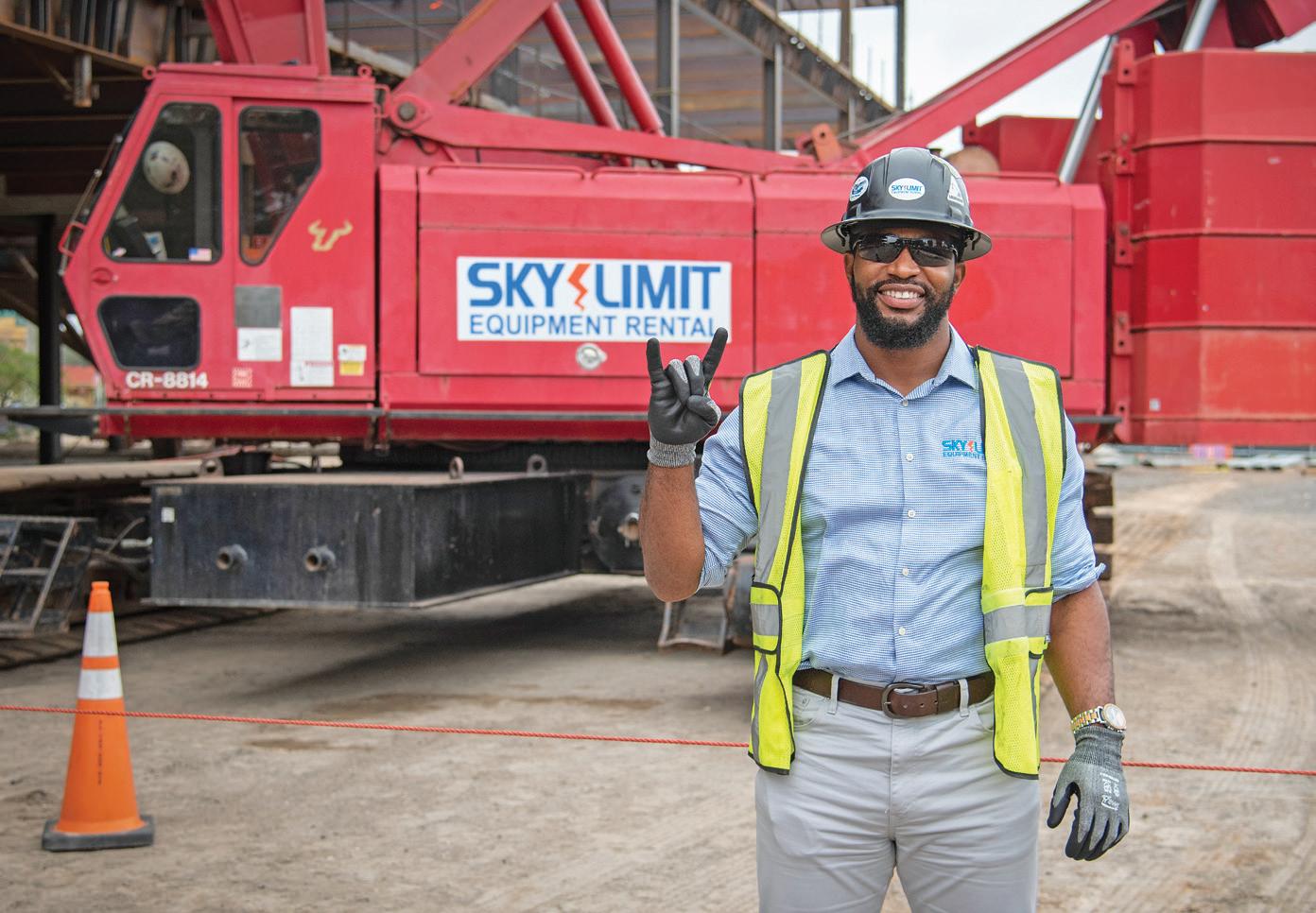

Photos: RYAN NOONE | USF News
Former Bulls linebacker Sam Barrington ’12, and his Sky Limit Equipment team have played a key role in the construction of the new USF Research Park building.
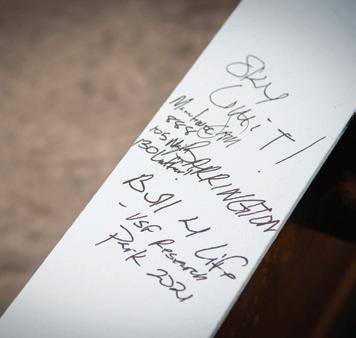
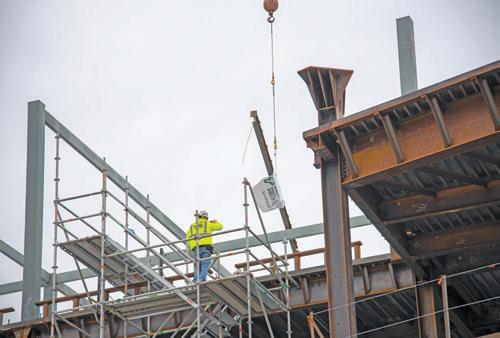
One person Barrington made sure to mention by name is Terrie Daniel, USF’s assistant vice president of supplier diversity.
“It’s an amazing opportunity and there’s so many people to thank for helping us along the way,” Barrington says.
Developing great working relationships previously paved the way for Sky Limit Equipment LLC to work on the Morsani College of Medicine building in downtown Tampa.
Different field, same work ethic for Barrington
Much like his playing style at USF and as a five-year NFL veteran, Barrington relentlessly pursues success as a versatile professional.
In the midst of major work projects, USF’s 10th all-time leading tackler (258 stops) has been an analyst on Bulls football radio broadcasts for three seasons and still finds time to reach new heights.
On April 22, he’ll receive the 2021 USF Outstanding Young Alumni Award and this May, the Renaissance man is scheduled to graduate from USF with an Executive Master of Business Administration degree. That will add another shining chapter to the family book of Barrington accomplishments. In earlier chapters, his father, Sam Sr., used his longtime construction experience and personal initiative to become founder of Sky Limit Structure Builders, LTD in Ghana along with Sky Limit Foundation, LLC in the U.S.
“My dad has always been a hard-working man and my mother has always been a hard-working woman,” Barrington says. “That’s the legacy of our family – hard workers.”
Once Barrington’s pro football career came to a close in 2017, he joined the family business and eventually earned his way up to acting president of Sky Limit Equipment LLC.
“I think it’s just about finding a purpose and finding things you enjoy and having meaning to them and including those in your purpose,” he says.
Now instead of tackling ball carriers, Barrington runs a business that steel erectors regularly lean on in addition to Sky Limit’s fleet capabilities, such as crane rental, rigging and hauling.
Construction is a different arena than football, but all the elements of achieving gridiron greatness translate well outside the lines, according to the Green Bay Packers’ seventh-round pick in 2013. Perseverance, teamwork and precision can apply well to other professional platforms and Barrington certainly practices what he preaches.
“I think an important takeaway is former players have to understand they have everything it takes to do well as an entrepreneur or business leader,” he says. “They just have to employ the same character traits and skills they used to make them successful on the field in their new professions.”
Soon enough, USF football players of the past and present will be able to look to the new building at the USF Research Park as inspiration. Other motivational monuments come in the form of rollercoasters at Disney, buildings at Tampa International Airport, and the JW Marriott Tampa on Water Street.
Stay tuned to see what Barrington’s Sky Limit venture accomplishes next.
“We’re a small business, but we’re growing,” he says. “We value new customers because we understand they could have gone anywhere in the world, but they’re right here with us.”




